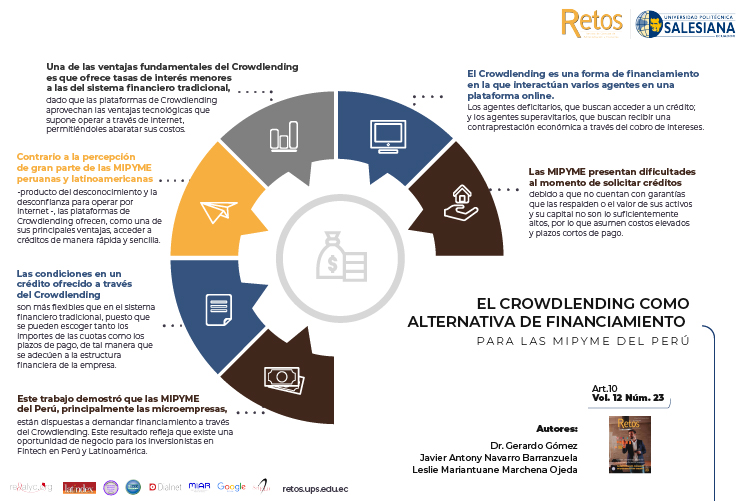El crowdlending como alternativa de financiamiento para las mipymes del Perú
Main Article Content
Abstract
Article Details

This work is licensed under a Creative Commons Attribution-NonCommercial-ShareAlike 4.0 International License.
Authorship: The list of authors signing must include only those people who have contributed intellectually to the development of the work. Collaboration in the collection of data is not, by itself, a sufficient criterion of authorship. "Retos" declines any responsibility for possible conflicts arising from the authorship of the works that are published.
Copyright: The Salesian Polytechnic University preserves the copyrights of the published articles, and favors and allows their reuse under the Creative Commons Attribution-NonCommercial-ShareAlike 3.0 Ecuador license. They may be copied, used, disseminated, transmitted and publicly displayed, provided that: i) the authorship and the original source of their publication (journal, editorial and work URL) are cited; (Ii) are not used for commercial purposes; Iii) mention the existence and specifications of this license.
References
Aguilar y Santillán, M. (06 de Agosto de 2021). Asociación Interamericana de Contabilidad. Obtenido de http://contadores-aic.org/analisis-de-la-sostenibilidad-de-las-mipymes-por-el-efecto-de-la-pandedimia-covid-19/
Arbulú, J., y Otoya, J. (2006). La PYME en el Perú. PAD Revista de egresados, 32-37.
Banco Central de Reserva del Perú. (Mayo de 2021). Reporte de estabilidad Financiera. Lima, Perú.
Bartra, R., Calderón, M., Espinoza, C., y Zavala, I. (2016). Plan de negocio para la formación de una empresa que administre una plataforma virtual Crowdlending que facilite el acceso al financiamiento de los microempresarios. Lima.
Basurco, A. C. (2016). Las MIPYMES y su incidencia en la generación de empleo en el Perú: período 2005-2014. Trujillo.
Boitan, I. (2016). Crowdlending and Financial Inclusion Evidence from EU Countries. Economic Alternatvies, 418-432.
Borrego, J. L., y Gil, D. (2018). Creación de una plataforma de Crowdlending. Madrid: Colegio Univesitario de Estudios Financieros.
Bortesi, L., Calderón, L., Montes, E., Ramón, J., y Vladimir, R. (2014). Alternativas de financiación de las PYME: Posibilidad de desarrollo. Lima.
Camacho, S. (2016). El Crowdfunding: régimen jurídico de la financiación participativa en la ley 5/2015 de fomento de la financiación empresarial. CESCO de Derecho de Consumo, 85-115.
Capital LoanBook. (2017). Crowdfunding: ¿cómo conseguir financiación complementaria, ágil y transparente? Madrid.
Chen, D., y Han, C. (2012). A Comparative Study of online P2P Lending in the USA and China. Journal of Internet Banking and Commerce, 02-15.
Colectual. (2016). Guía sobre el Crowdlending en España. Madrid.
Cuesta, P., y Torre, M. (2017). La evolución del Crowdlending en España. Cantabria.
Dini, M., y Stumpo, G. (2018). MIPYMES en América Latina: Un frágil desempeño y nuevos desafíos para las políticas de fomento. Santiago de Chile: Naciones Unidas.
Estarellas, K. (2015). Crowdfunding una nueva alternativa de financiación en auge (memoria del trabajo de in de grado). San Cristobal de la Laguna.
Guerrero, F., Paradas, M., y Torres, A. (2017). Financiamiento utilizado por las pequeñas medianas empresas ferreteras. Maracaibo: tesis de pregrado.
Gutiérrez, M. (2018). ¿Cómo regular? Una aproximación al Crowdlending, desde la perspectiva del regulador, como mecanismo adicional del acceso al financiamiento de las micro, pequeñas y medianas empresas. Lima.
Hernández, H. (2002). Matemáticas Financieras Teoría y Práctica. México: Ediciones Contables, Administrativas y Contables S.A.
Information por Development Program - infoDev. (2013). Crowdfunding's Potential for the Developing World. Washington DC: World Bank.
Instituto Nacional de Estadística e Informática [INEI, 2019]. Encuesta Nacional de Empresas. Disponible en: https://www.inei.gob.pe/media/MenuRecursivo/publicaciones_digitales/Est/Lib1590/libro.pdf [accesado el 27 de mayo de 2019]
Käfer, B. (2016). Peer-to-Peer Lending: a (Financial Stability) Risk Perspective. Hesse: Universitat Kassel.
Lenz, R. (2016). Peer-to-Peer Lending: Opportunities and Risks. European Journal of Risk Regulation, 688-700.
Lerma, A., y Martin, M. (2007). Liderazgo emprendedor: Como ser un emprendedor de éxito y no morir en el intento. Ciudad de México: International Thomson Ediciones .
Loës, C. (2017). Financing to micro-enterprises Microfinance versus Crowdlending: what future? Luxemburgo.
López, E. (2016). ¿Qué es Fintech? Obtenido de Crowlending.es: https://www.Crowdlending.es/blog/que-es-Fintech
Massolution. (2015). The Crowdfunding Industry Report. Crowdsourcing LLC.
Milaap. (14 de Junio de 2017). Understanding The Background of Debt-based Crowdfunding. Obtenido de Milaap: Crowdfunding for India: https://milaap.org/stories/debt-based-Crowdfunding
MyTripleA. (2016). Guía para invertir en Crowdlending. Barcelona: Madrid.
Omarini, A. (2018). Peer-to-Peer Lending: Business Model Analysis and the Platform Dilemma. International Journal of Finance, Economic and Trade, 31-41.
OXERA. (2016). The economics of peer-to-peer lending.
Pesca , H. (2017). Crowdfunding y el financiamiento de PYME en Colombia. Civilizar de empresa y economía, 47-70.
Ramírez, L., y Muñoz, S. (2015). El Crowdlending como nueva herramienta de financiación. Análisis de su incidencia en España. Sevilla.
Rodríguez, T. (2013). El Crowdfunding: una forma de financiación colectiva, colaborativa y participativa de proyectos. Pensar en Derecho, 101-123.
San-Jose, L., y Retolaza, J. L. (2016). International Perspectives on Crowdfunding: Positive, Normaty and Critical Theory. Portland: Ringgold Inc.
Zetzsche, D., y Preiner, C. (2018). Cross-Border Crowdfunding: Towards a Single Crowdlending and Crowdinvesting Market for Europe. Luxemburgo: ASSER.

